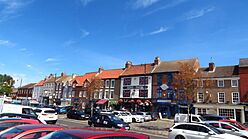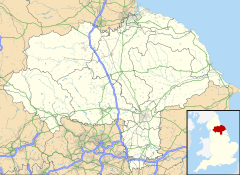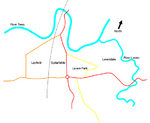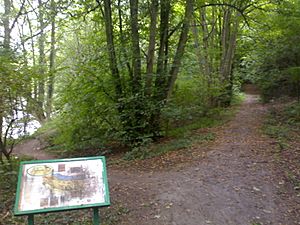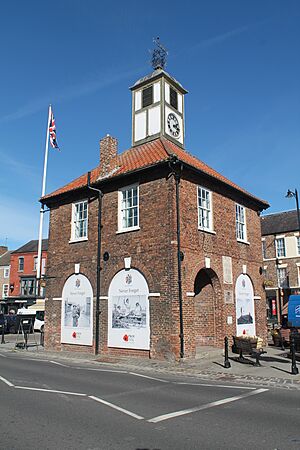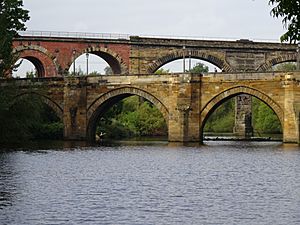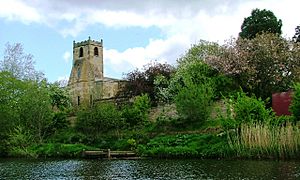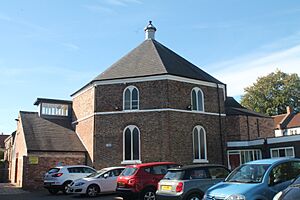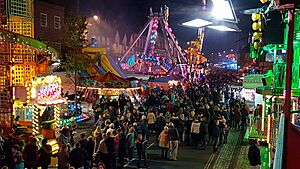Yarm facts for kids
Quick facts for kids Yarm-on-Tees
|
|
|---|---|
| Market town and civil parish | |
|
Yarm Town Hall
Hope House, believed to be the oldest building in Yarm
Yarm Viaduct spanning the town
Residential houses around the old market area
Yarm High Street
|
|
| Population | 9,600 (small town, 2021 census) |
| OS grid reference | NZ416124 |
| Civil parish |
|
| Unitary authority |
|
| Ceremonial county | |
| Region | |
| Country | England |
| Sovereign state | United Kingdom |
| Post town | YARM |
| Postcode district | TS15 |
| Dialling code | 01642 |
| Police | Cleveland |
| Fire | Cleveland |
| Ambulance | North East |
| EU Parliament | North East England |
| UK Parliament |
|
| Website | www.YarmTC.org |
Yarm-on-Tees, often called just Yarm, is a historic market town in North Yorkshire, England. It sits on a bend, or meander, of the River Tees. The town also stretches towards the River Leven in the southeast and the village of Kirklevington in the south. Yarm is part of the Borough of Stockton-on-Tees. It is about 5 miles (8 km) northeast of Stockton-on-Tees and 11 miles (18 km) west of Darlington.
Yarm is famous for its High Street. In 2007, a BBC Breakfast poll voted it Britain's best High Street! The impressive Yarm Viaduct also crosses the town. Locals know Yarm for its fun annual funfair too.
Contents
History of Yarm
The name Yarm likely comes from an old English word, gearum. This word meant 'at the place of the fish pools'. This suggests that people used to catch fish here a long time ago. Yarm was first written about in the Domesday Book in 1086. It started as a small church area within the Kirklevington parish. Later, it became its own parish.
The Viking Helmet Discovery
A very special Viking Age helmet, called the Yarm helmet, was found in Yarm. It is from around the 10th century. This helmet is the first almost complete Anglo-Scandinavian helmet found in Britain. It is also only the second Viking helmet found in northwest Europe! You can see it on display at Preston Park Museum in Preston-on-Tees.
Friars and Old Buildings
Around 1286, a group of Dominican Friars came to Yarm. They had a friary (a type of monastery) and a hospital in the town until 1583. The names Friarage and Spital Bank still remind us of them today. The Friarage building, now part of Yarm School, was built in 1770. It sits on top of the old friary's cellars.
Bridges and Rivers
In 1400, Bishop Skirlaw of Durham built a stone bridge over the River Tees. This bridge is still standing today! For many years, Yarm was the highest point on the River Tees where ships could travel.
The First Public Railway
On February 12, 1821, an important meeting happened at the George & Dragon Inn in Yarm. This meeting helped push for the building of the Stockton & Darlington Railway. This railway became the world's first public railway!
Yarm's Status Changes
In the 13th century, Yarm was considered a borough, which is a special type of town. However, it did not keep this status. Over the years, Yarm's local government changed several times. In 1974, it became part of the district of Stockton-on-Tees. In 1996, Stockton-on-Tees became a unitary authority, meaning it manages its own local services.
Geography of Yarm
Yarm is surrounded by two rivers. The River Tees is to the north, and the River Leven is to the east. The Leven flows into the Tees. Yarm used to be the highest port on the River Tees.
Bridges in Yarm
Two road bridges cross the rivers. Yarm Bridge connects the High Street to Eaglescliffe. Leven Bridge crosses the Leven between Yarm and Low Leven. Both bridges are very old and have special historical protection. In 2010, Leven Bridge had to close for repairs, but it reopened quickly.

Yarm High Street
Yarm Town Hall is on the High Street. It was built in 1710 by Thomas Belasyse, who was the Lord of the Manor. As mentioned, Yarm's High Street was voted the 'Best High Street' in 2007. It has many beautiful Georgian-style buildings with red roofs. The street also has cobbled areas for parking.
Roads and Traffic
The A67 road runs through Yarm's High Street. This road used to be a major route, the A19, until a new dual carriageway was built in the 1970s. When the A19 went through the High Street, it was very busy with heavy trucks. The town council worked to reduce this traffic. Since 2012, most large trucks are not allowed to use the route through Yarm and Eaglescliffe.
The Rookery Woodland
The Rookery is a public green space next to the River Tees. It is a woodland area with ash, sycamore, and lime trees, about 200 years old. Yarm Town Council owns this area. In 2002, a walkway was built around the wood to celebrate Queen Elizabeth II's Golden Jubilee. BMX riders also use parts of the woodland for dirt ramps.
Governance in Yarm
Yarm is part of the Stockton Borough Council. This council manages local services for the area.
Yarm Town Council
Yarm also has its own town council. This council looks after things like local gardens (allotments) and the cemetery. The council meets once a month at the town hall. There are eleven members on the council. The person in charge is called the 'Mayor' for special events. Elections for the council happen every four years.
Transport in Yarm
Railway Connections
The Yarm railway station opened in 1996. It is located near Conyers' School, about 1 mile (1.6 km) south of Yarm High Street. Eaglescliffe railway station also serves Yarm.
The long Yarm Viaduct is a railway bridge that crosses the town. It is 2,280 feet (695 meters) long! It was built between 1849 and 1851. The viaduct has 43 arches and used seven million bricks. The two arches over the River Tees are made of stone and are built at an angle.
Air Travel
Teesside International Airport is located between Yarm and Darlington. It offers flights to different places, both within the UK and abroad.
Road Network
Yarm's High Street is part of the A67 road. To the north of the High Street, the A135 Yarm Road goes northeast towards Stockton-on-Tees. The A67/Durham Road goes northwest towards the airport and Darlington. To the south, the High Street connects to the main A19 road. Other roads like the B1265 Green Lane also link Yarm to nearby towns and areas.
Religion in Yarm
Yarm Parish Church is an Anglican parish church. It is called St Mary Magdalene. There has been a church on this spot since at least the 9th century. The current church was rebuilt in 1730. It is a very old and important building.
The Roman Catholic church of Ss Mary and Romuald was built in 1860. It is at the south end of the High Street.
Yarm Methodist Church is a unique church built in 1763. It has eight sides, making it an octagon. It is the oldest octagonal church still used by Methodists today.
Media and News
Local news and TV shows for Yarm come from BBC North East and Cumbria and ITV Tyne Tees. There is also a local TV station called TalkTeesside. You can listen to local radio stations like BBC Radio Tees and Heart North East. The town also has local newspapers, TeessideLive and The Northern Echo.
Sports in Yarm
Rugby and Cricket
Yarm Rugby Club is located in Eaglescliffe. It started in 1998 and has grown a lot. They have teams for many different ages, from kids to adults. Yarm Wolves is another local rugby team.
Yarm Cricket Club has been around since 1814! It has three adult teams and four junior teams (under 11s, 13s, 15s, and 17s). They all play in local leagues.
Football
Yarm and Eaglescliffe FC is a football club that started in 2017. There is a 4G football pitch at Conyers' School. This pitch is used by local adult and youth football clubs, including Yarm FC.
Community and Culture
Yarm has a weekly market, which was first allowed by King John in 1207. This market charter is why Yarm has its historic status as a town. The market is held on the second Sunday of each month.
Yarm Funfair
Every year, a funfair comes to the High Street in the third week of October. This funfair tradition grew from an old fair where people used to trade cheese and livestock (farm animals).
Performance Venues
The Princess Alexandra Auditorium is a large venue with 750 seats. It opened in 2012 as part of Yarm School's new buildings. There is also a smaller Friarage Theatre on the same site, which has 140 seats.
Education in Yarm
Yarm has three primary schools for younger children:
- Levendale Primary School
- Yarm Primary School
- Layfield Primary School
For older students, secondary education is provided at Conyers' School. Yarm is also home to Yarm School, which is an independent school.
Twinned Towns
Yarm is twinned with two towns in other countries. These are Vernouillet in France and Schwalbach am Taunus in Germany. Being twinned means the towns have a special friendship and often share cultural exchanges. In 2005, two trees were planted in Yarm to celebrate 20 years of this twinning.
Notable People from Yarm
- Tom Brown: A famous soldier who was the last person to be knighted on a battlefield. His old house on the High Street is one of the oldest homes in the area.
- Janick Gers: A guitarist for the famous band Iron Maiden.






